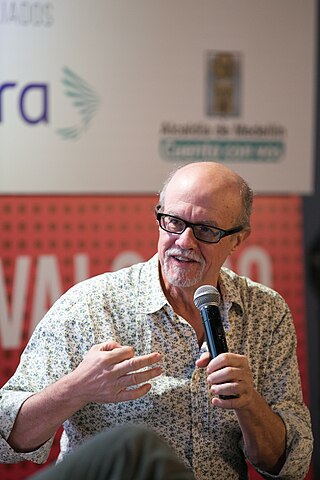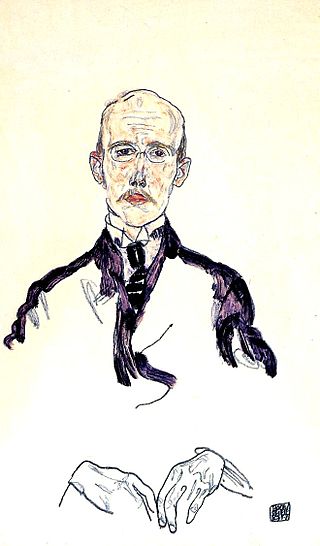Related Research Articles

Egon Leo Adolf Ludwig Schiele was an Austrian Expressionist painter. His work is noted for its intensity and its raw sexuality, and for the many self-portraits the artist produced, including nude self-portraits. The twisted body shapes and the expressive line that characterize Schiele's paintings and drawings mark the artist as an early exponent of Expressionism. Gustav Klimt, a figurative painter of the early 20th century, was a mentor to Schiele.

The Belvedere is a historic building complex in Vienna, Austria, consisting of two Baroque palaces, the Orangery, and the Palace Stables. The buildings are set in a Baroque park landscape in the third district of the city, on the south-eastern edge of its centre. It houses the Belvedere museum. The grounds are set on a gentle gradient and include decorative tiered fountains and cascades, Baroque sculptures, and majestic wrought iron gates. The Baroque palace complex was built as a summer residence for Prince Eugene of Savoy.

The Österreichische Galerie Belvedere is a museum housed in the Belvedere palace, in Vienna, Austria.

Nazi plunder was organized stealing of art and other items which occurred as a result of the organized looting of European countries during the time of the Nazi Party in Germany.

The Leopold Museum, housed in the Museumsquartier in Vienna, Austria, is home to one of the largest collections of modern Austrian art, featuring artists such as Egon Schiele, Gustav Klimt, Oskar Kokoschka, and Richard Gerstl.

Portrait of Adele Bloch-Bauer I is an oil painting on canvas, with gold leaf, by Gustav Klimt, completed between 1903 and 1907. The portrait was commissioned by the sitter's husband, Ferdinand Bloch-Bauer, a Viennese and Jewish banker and sugar producer. The painting was stolen by the Nazis in 1941 and displayed at the Österreichische Galerie Belvedere. The portrait is the final and most fully representative work of Klimt's golden phase. It was the first of two depictions of Adele by Klimt—the second was completed in 1912; these were two of several works by the artist that the family owned.

Hector Feliciano is a Puerto Rican journalist and author whose book "The Lost Museum: The Nazi Conspiracy to Steal the World's Greatest Works of Art" has shed light on an estimated 20,000 works of art plundered by the Nazis; each one is owned by a museum or a collector somewhere.
Rudolf Leopold was an Austrian art collector, whose collection of 5,000 works of art was purchased by the Government of Austria and used to create the Leopold Museum, of which he was made director for life. Claims had been made by Jewish survivors of the Holocaust that some of the pieces in the collection were Nazi plunder and should be returned to their rightful owners.

Portrait of Wally is a 1912 oil painting by Austrian painter Egon Schiele of Walburga "Wally" Neuzil, a woman whom he met in 1911 when he was 21 and she was 17. She became his lover and model for several years, depicted in a number of Schiele's most striking paintings. The painting was obtained by Rudolf Leopold in 1954 and became part of the collection of the Leopold Museum when it was established by the Austrian government, purchasing 5,000 pieces that Leopold had owned. Near the end of a 1997–1998 exhibit of Schiele's work at the Museum of Modern Art in New York, the painting's ownership (provenance) history was revealed in an article published in The New York Times. After the publication, the heirs of Lea Bondi Jaray, to whom the work had belonged before World War II, contacted the New York County District Attorney who issued a subpoena forbidding its return to Austria. The work was tied up in litigation for years by Bondi's heirs, who claimed that the painting was Nazi plunder and should have been returned to them.

Bettina "Nina" Burr is vice president of the board of trustees of the Museum of Fine Arts, Boston, to which she and other members of her family made a major donation of Rothschild family heirlooms that is known as The Rothschild Collection.

Karl Mayländer was an Austrian art collector and businessman who was deported in 1941 from Vienna to Łódź, in German-occupied Poland, by the Nazis and later murdered in the Shoah.
Jane Kallir is an American art dealer, curator and author. She is co-director of the Galerie St. Etienne in New York, which specializes in Austrian and German Expressionism as well as self-taught and “outsider” art. In 2020, the gallery ceased commercial operations and became an art advisory. Its archives and library were transferred to the Kallir Research Institute, a foundation established in 2017. Kallir serves as President of the KRI. She has curated exhibitions for many American and international museums and is the author of the catalogue raisonné of Egon Schiele’s work in all mediums.

Dead City III is an oil on wood expressionist painting by Egon Schiele from 1911. It was owned by the Viennese cabaret artist Fritz Grünbaum before he was murdered by Nazis and has been the object of high-profile disputes and court battles. Suspected by New York's District Attorney of having been looted by the Nazis, Dead City III was temporarily confiscated from the Austrian art collector Rudolf Leopold after he loaned it to a New York museum in 1998. The ownership history of the painting has been the object of high-profile court cases in which two very different versions of the painting's journey from the Jewish Holocaust victim to the Austrian art collector collide.
Lea Bondi, later Lea Jaray or Lea Bondi-Jaray was an Austrian art dealer and art collector who was forced to emigrate to Great Britain due to Nazi persecution after the annexation of Austria to the Nazi German Reich. The Würthle Gallery, which she ran, was "Aryanized" by Nazis and her art collection, including the Portrait of Wally by Egon Schiele, extorted.
Heinrich Rieger was an Austrian dentist whose art collection was one of the most important in Austrian modern art. Rieger and his wife were murdered in the Holocaust.

Walburga "Wally" Neuzil was an Austrian nurse who was the lover and muse of the artist Egon Schiele between 1911 and 1915.
Oscar Reichel was an Austrian physician and art collector. His work was confiscated by the Nazis during World War II, leading to claims from his descendants to restore it to them.
Friedrich Maximilian Welz was an Austrian art dealer and Nazi Party member investigated for art looting.

Jenny Steiner was an Austro-Hungarian art collector, patron of the arts and factory owner expropriated under the Nazis.
References
- ↑ Columbia University Graduate School of Journalism faculty webpage Archived 2007-06-07 at the Wayback Machine
- ↑ Dobrzynski, Judith H. "A Singular Passion for Amassing Art, One Way or Another". The New York Times, 24 December 1997.
- ↑ Herrick Press Release July 20, 2010
- ↑ Perlez, Jane. "Austria is set to Return Artworks Confiscated From Jews by Nazis". "The New York Times", 7 March 1998.
- ↑ Perlez, Jane. "Austria Moves Toward Returning Artworks Confiscated by Nazis". The New York Times, 11 September 1998.
- ↑ "Bettina Looram". The Telegraph. 2012. Retrieved 27 September 2017.
- ↑ Dobrzynski, Judith H. "Online Bid Soars to $135,805, Provenance Not Guaranteed". The New York Times, 9 May 2000.
- ↑ Dobrzynski, Judith (June 2, 2000). "In Online Auction World, Hoaxes Aren't Easy to See". The New York Times. Retrieved 27 September 2017.
- ↑ Walton, Kenneth (2006). Fake: Forgery, Lies & eBay. Simon & Schuster. p. 133. ISBN 1416934618 . Retrieved 27 September 2017.